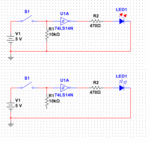indemnity83
Newbie level 3

- Joined
- Aug 17, 2013
- Messages
- 4
- Helped
- 0
- Reputation
- 0
- Reaction score
- 0
- Trophy points
- 1
- Activity points
- 82
Rising/Falling edge detector with negative output pulse
I'm either doing something wrong, fried the chip, or just am in above my head.
I have an NTE74LS14 chip (Hex Schmitt Trigger Inverter http://www.nteinc.com/specs/7400to7499/pdf/nte74LS14.pdf) and was trying to following an article about edge detection **broken link removed** but I can't seem to get anything to work right.
So I simplified; and still didn't get anything like I expected. I expected that with the switch open, the LED would be on and with the switch closed the LED would go out ... what am I doing wrong:
**broken link removed**
I'm either doing something wrong, fried the chip, or just am in above my head.
I have an NTE74LS14 chip (Hex Schmitt Trigger Inverter http://www.nteinc.com/specs/7400to7499/pdf/nte74LS14.pdf) and was trying to following an article about edge detection **broken link removed** but I can't seem to get anything to work right.
So I simplified; and still didn't get anything like I expected. I expected that with the switch open, the LED would be on and with the switch closed the LED would go out ... what am I doing wrong:
**broken link removed**






